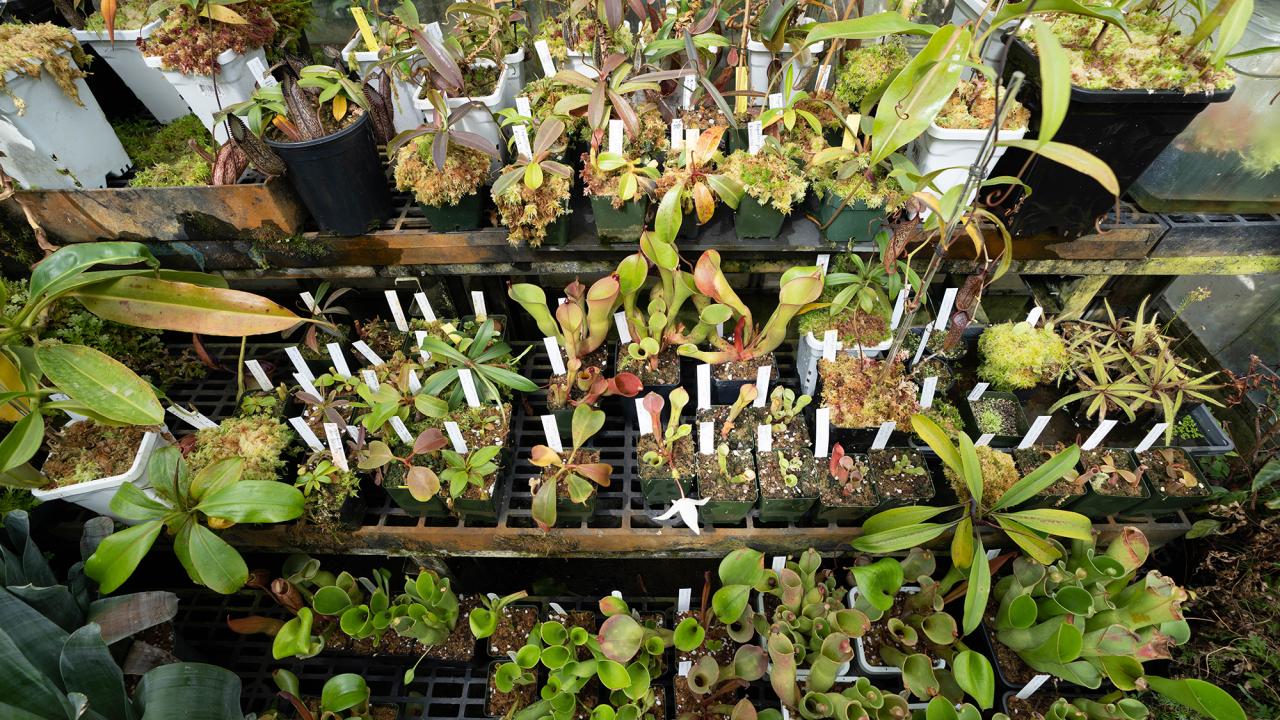
UC Davis Botanical Conservatory Resumes Popular Rare-Plant Sales
Houseplant aficionados, start your engines! More than 60 species of tropical plants—including some rare species, carnivorous plants, succulents, and more—will be on offer on Saturday, April 19 from 10:00am until 2:00pm at bargain prices, as the UC Davis Botanical Conservatory resumes its highly popular plant sales.
Conservatory curator Marlene Simon says the most sought-after and unusual plant for sale will be Welwitschia mirabilis, a unique species that can live for hundreds of years in its native habitat. Thought to be a relic of the Jurassic period, it’s found in the wild in isolated pockets along the coast of Namibia and Angola, where the moisture of marine fog is a critical water source.
But as distinctive as it is, Welwitschia is just one of the fascinating species nurtured in the Botanical Conservatory, which holds specimens representing some 280 plant families—nearly half of the 600 plant families found in the world.

A Living Museum
The sale will also include begonias, hoyas, aroids, and much more, all propagated from the conservatory’s collection. “It’s a repository of genetic diversity,” says Simon, who graduated from UC Davis with a degree in in environmental horticulture in 1999, interned with the conservatory as a student, later volunteered, and officially joined the staff in 2008. “We have close to 4,000 different species, including many on the critically endangered list.”
The conservatory, which began in 1959 as a teaching collection of coleus plants, has grown to comprise three large greenhouses and supports both research and teaching at the university. Its collection is used not only in introductory and plant biology classes, but also in art, photography, textile, and ethnobotany courses. It also supports research. Currently, that includes propagating the rare Wollemi pine, native to Australia, for a hormone project and growing Venus fly traps for postdoctoral research.
The conservatory’s main greenhouse also engages in public outreach. It’s open to the public for self-guided visits and for guided tours and educational activities for “anyone from kindergarten all the way through Master Gardeners,” says Simon. “We consider ourselves a living museum.” Simon—who is known as “The Plant Lady” —also does outreach of her own via her popular Instagram account @marlenetheplantlady, featuring hundreds of photos and videos of the conservatory’s collection. (More can also be found at the conservatory’s official account.)
Originally, the conservatory held plant sales in conjunction with the UC Davis Arboretum and Public Garden, but each facility’s offerings were quite different. “People who were carnivorous plant growers or orchid collectors would rush to us,” says Simon. “Most of our plants are indoor house plants, because they’re tropical, so we decided to try having our own plant sale in the parking lot.”

When Houseplants Became Cool
Then came the trend for cultivating houseplants, and the sales “really took off,” says Simon. “To those of us who have been surrounded by them, plants were always cool. But my coworker and I looked at each other one day and we were like, ‘How are plants cool for young people again?’” says Simon with a laugh.
Initially, plant sales were held on weekdays, catering mainly to students, says Simon. “We probably had a couple hundred people each time, and we'd sell out of certain plants,” she says. News of the sales spread through word of mouth, however, and Simon started hearing from non-students who wanted to attend but couldn’t. As a result, this time sales will be held on weekends, making them more accessible to university staff and members of the public.
The sale is also designed to be affordable. “We've always been known for affordable prices,” says Simon. Most plants will go for around $7, with the rarest and biggest plants topping out in the $50 range.
A Mutual Benefit
Revenue from this sale will support the work of the conservatory, and also gives surplus plant material a good home. “Without the sales, when we divide or prune, plants would just go in the compost bin, or we’d put it out for people to scavenge,” says Simon. “Now we can take all this cutting material and make use of it.”
Reviving the sales after years on pause has taken some effort. “We’ve been busy propagating as many species as possible to ensure we have enough inventory on hand,” says Simon. “We’ll have anywhere from two- to five-inch-sized plants all the way up to three-gallon ones, but the majority will be small. That way, students don’t have to take home a giant plant, and the cost stays lower.”
All the work, however, is a labor of love, rewarded by the public’s enthusiasm. “People ask about the sales constantly,” says Simon. “It’s exciting to start them up again.”
The first plant sale will take place April 19, 2025, from 10 a.m. to 2 p.m., in the north parking lot of the conservatory building. Cash and checks will be accepted (no credit cards, Venmo or other electronic payment methods). Parking is free.
Media Resources
- Kate Washington, Ph.D., is a freelance writer based in Sacramento and the author of Already Toast: Caregiving and Burnout in America. Her work has appeared in the New York Times, TIME and Sunset, among other publications.
- UC Davis Botanical Conservatory
